When choosing home solar panels, start by evaluating your energy needs, calculating monthly consumption and desired offset percentage. Next, compare solar panel types like monocrystalline for high efficiency or polycrystalline for affordability. Evaluate panels based on their efficiency ratings and output to guarantee you meet your energy requirements. Look into warranty options, as a robust warranty can greatly protect your investment. Consider installation factors like roof orientation and shading. Analyze the balance between cost and quality, making sure you select reputable brands with positive customer feedback. Each of these steps will guide you to a suitable solar solution for your home.
Assess Your Energy Needs
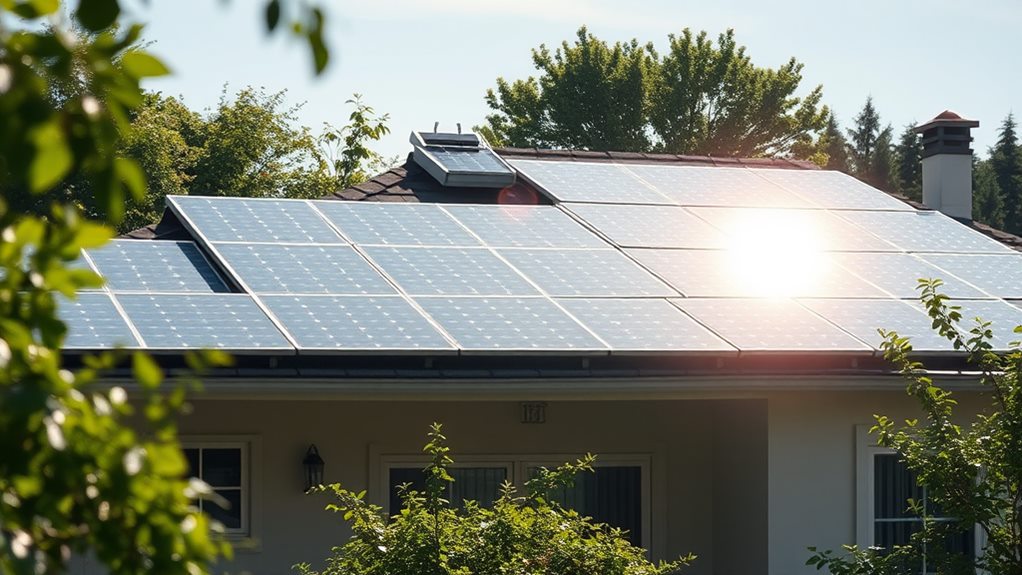
To effectively assess your energy needs for a solar panel system, start by reviewing your electricity bills from the past year. This will help you calculate your average monthly energy consumption in kilowatt-hours (kWh), forming a baseline for your solar energy needs.
Understanding the available solar energy tax credits can also aid in deciding how much energy you wish to offset. Next, identify the percentage of your energy usage you wish to offset with solar power. Many homeowners aim for at least 70-100% to achieve considerable savings.
You'll also want to calculate the total wattage of the appliances you use regularly. Be sure to take into account both their starting and running wattage to account for peak demand accurately.
Additionally, keep in mind the seasonal variations in sunlight, as these can greatly impact how much energy your solar panels will generate throughout the year.
Lastly, assess your home energy efficiency measures, such as insulation and energy-efficient appliances. These factors can lower your overall energy demand, potentially reducing the size of the solar system required.
Compare Solar Panel Types
Once you've assessed your energy needs, the next step is to compare the different types of solar panels available. You'll encounter several solar panel types, each with unique characteristics.
Monocrystalline panels stand out for their high efficiency, typically ranging from 20% to 22%. This makes them ideal if you have limited roof space, as they produce more energy per square foot. Additionally, switching to solar power can lead to significant financial savings over time, making the upfront investment more worthwhile.
On the other hand, polycrystalline panels are generally less expensive, but their efficiency ranges from 15% to 17%, requiring more panels to achieve the same energy production.
Thin-film panels offer lightweight and flexible options, though their efficiency is lower, around 10% to 12%. They're suitable for unconventional installations but aren't common for home solar systems.
If you want enhanced energy production, consider bifacial panels, which capture sunlight from both sides, potentially increasing total output by up to 20% in reflective environments.
Lastly, half-cut solar panels employ a design that reduces resistance, providing efficiency levels similar to monocrystalline panels while being more cost-effective.
Evaluate Panel Efficiency
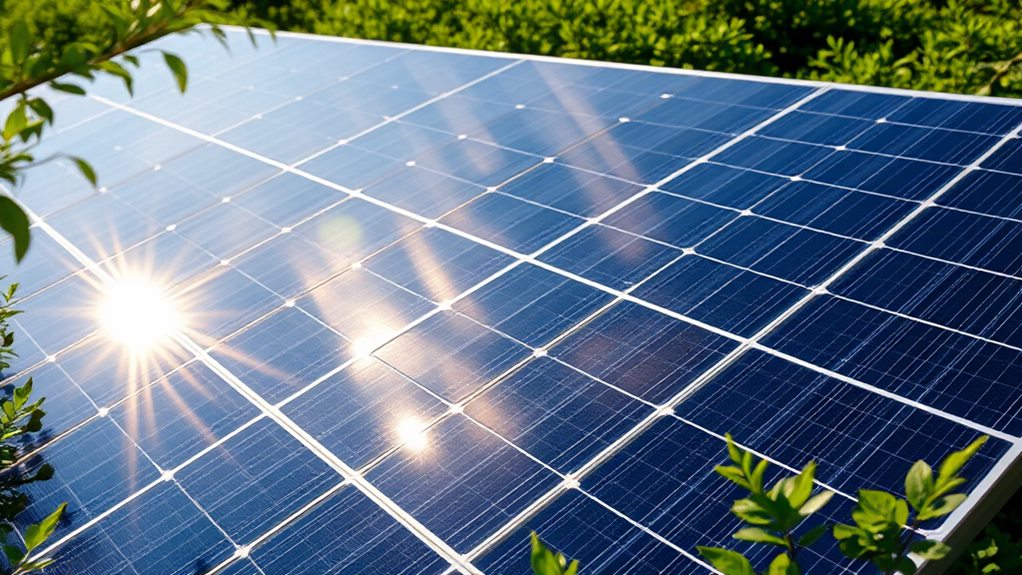
When evaluating solar panel efficiency, it's essential to understand efficiency ratings, as these indicate how well a panel converts sunlight into electricity.
Different types of solar panels, such as monocrystalline cells known for their high performance, can vary greatly in energy output. You should compare the energy output of different types, like monocrystalline and bifacial panels, to determine which option best suits your needs.
Additionally, reviewing the long-term benefits can help you make an informed decision that maximizes your investment in solar energy, especially considering the market trends and services that can provide valuable insights.
Understand Efficiency Ratings
Understanding efficiency ratings is fundamental for choosing the right solar panels for your home. Solar panel efficiency typically ranges from 15% to 22%, with higher ratings indicating a greater conversion of sunlight into electricity.
If you have limited roof space, consider monocrystalline panels, which often exceed 20% efficiency, maximizing energy output without requiring extensive installation area. By investing in a system with higher efficiency, you may enhance your potential to eliminate utility bills entirely with solar investment, allowing for considerable money saving by switching to solar energy.
It's essential to recognize that various factors can affect efficiency ratings. For instance, shading and orientation can greatly impact the panel's performance. To achieve ideal performance, aim for installation in areas with direct sunlight and cooler temperatures.
Additionally, understanding the temperature coefficient of a panel is critical, as it indicates how performance degrades with rising temperatures. This knowledge is especially important if you live in warmer climates.
Bifacial panels are another option worth exploring. They capture sunlight from both sides, enhancing overall efficiency and potentially increasing energy production compared to traditional panels.
Compare Energy Output
Comparing energy output among solar panels is essential for making an informed decision that aligns with your energy needs. When evaluating solar panels, look closely at their efficiency ratings, which typically range from 15% to 22%.
Monocrystalline panels tend to offer the highest efficiency at around 20-22%, while polycrystalline panels usually range from 15-20%. This difference can greatly impact the number of panels you'll need to meet a specific output rating.
The output rating, measured in watts of electricity, indicates the maximum power a panel can produce under ideal conditions, with common ratings between 250 and 400 watts per panel. If you're limited on installation space, opting for higher efficiency panels guarantees you maximize energy output in a confined area.
Additionally, be aware of factors that can affect performance, such as shading and temperature coefficients. Generally, solar panels perform better at lower temperatures and in direct sunlight.
Bifacial panels, which capture sunlight from both sides, can enhance overall efficiency and increase energy production compared to standard panels. By carefully comparing these aspects, you can choose the right solar panels to effectively meet your energy needs.
Assess Long-term Benefits
Evaluating the long-term benefits of solar panels starts with reviewing their efficiency, which greatly impacts your energy savings over time. By understanding how different panel types perform, you can make an informed decision that maximizes your return on investment.
Here are three key factors to take into account:
- Efficiency Ratings: Solar panel efficiency typically ranges from 15% to 22%. Higher efficiency panels, like monocrystalline ones, often exceed 20%, producing more energy in less space, making them ideal for homes with limited roof area.
- Degradation Rate: The average degradation rate is about 0.5% to 1% per year. High-efficiency panels can maintain around 84% of their capacity after 25 years, ensuring consistent energy production.
- Upfront Costs vs. Long-term Savings: While high-efficiency panels may have higher upfront costs, they reduce the number of panels needed for installation. This not only lowers installation costs but also enhances overall system performance and long-term savings.
Check Warranty Options
When you're investing in home solar panels, checking warranty options is vital to guarantee you're getting a quality product. Look for warranties that span 25 to 30 years, as these indicate higher reliability and confidence in the solar panels' performance.
A robust warranty should include both product and performance coverage, protecting you against manufacturing defects and guaranteeing a minimum power output throughout the warranty period.
Pay attention to the degradation rate specified in the warranty. A good warranty typically allows for a maximum degradation of 0.5% per year after the initial year.
Understanding what's covered is essential; examine the terms for details on environmental damage, manufacturing defects, and the claims process.
Additionally, consider the brand's reputation and customer reviews. Brands with strong reputations are more likely to honor their warranties and provide reliable support.
By thoroughly checking warranty options, you can guarantee that your investment in solar panels not only meets your energy needs but also offers peace of mind.
Ultimately, a solid warranty reflects the quality and durability of the product, safeguarding your investment for years to come.
Consider Installation Factors
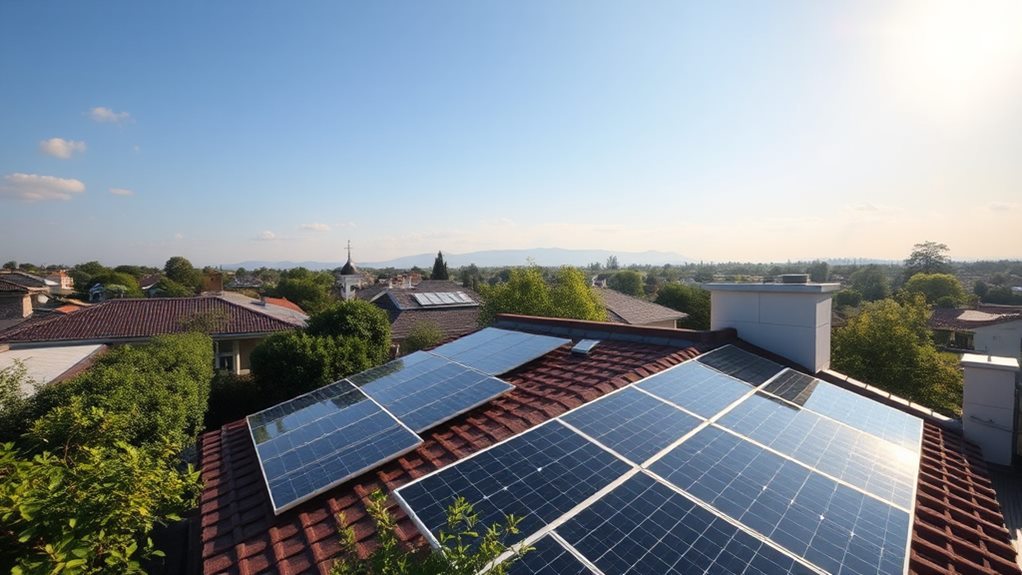
After securing a solid warranty for your solar panels, it's important to contemplate the installation factors that can impact performance and efficiency.
These elements play an essential role in optimizing your solar panel system, so pay attention to the following:
- Roof Orientation and Pitch: Ideally, your roof should face south and have a 30-degree angle. This setup maximizes sunlight exposure, leading to improved energy production.
- Structural Integrity: Before you install solar panels, verify your roof can support their weight. If your roof is older or needs repairs, it's wise to address these issues first to avoid future complications.
- Shading and Local Regulations: Evaluate any potential shading from nearby trees or buildings, as even partial shading can greatly reduce panel efficiency.
Don't forget to check local regulations and permitting requirements, as they can affect your installation timeline and practices.
Consult with professional solar installers to determine the best mounting systems suited for your specific roof type and local conditions.
Analyze Cost vs. Quality
Finding the right balance between cost and quality is essential for your solar panel investment. While lower-priced solar panels may seem appealing at first, they often lead to higher long-term costs due to poor performance and increased maintenance needs. The average cost per watt for residential installations ranges from $2.50 to $3.50, so it's critical to analyze your budget against the expected output and efficiency of the panels.
Investing in higher-quality solar panels can yield significant long-term savings on energy bills. For example, a 300-watt panel with a superior efficiency rating can produce more energy over its lifespan compared to a cheaper alternative. Thorough evaluation of performance and reliability is crucial, as low-quality panels may face degradation rates exceeding 0.5% per year, diminishing energy output over time.
Additionally, consider the total cost of ownership, including maintenance and potential repairs. High-quality panels typically boast longer lifespans of 25-30 years and robust warranties spanning 10-25 years, which can help offset their higher initial costs.
Research Brand Reputation
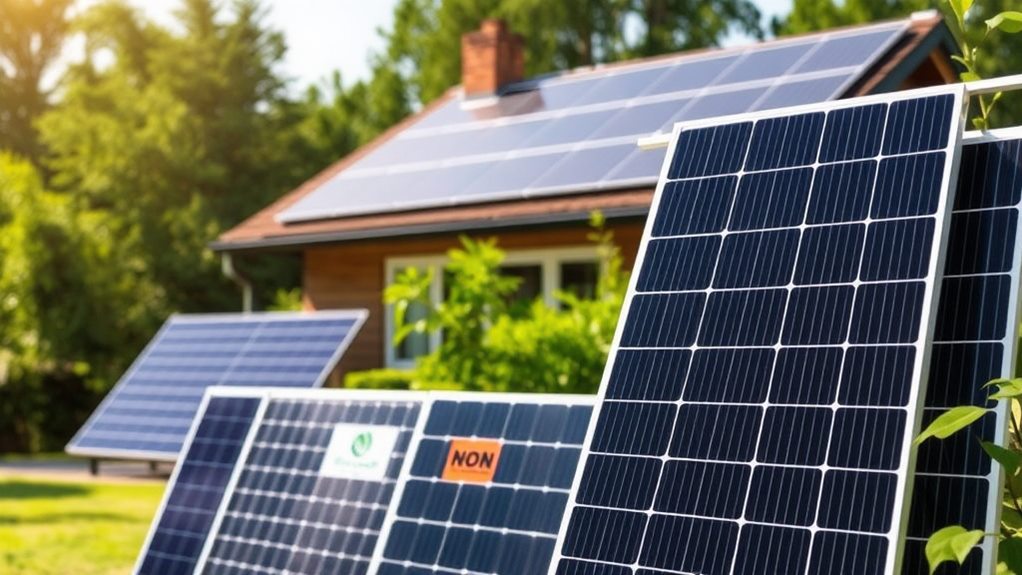
When researching a solar panel brand, it's essential to assess the manufacturer's history and reputation.
Look for companies that offer solid warranty options and have performance certifications to guarantee you're investing in quality products.
Assess Manufacturer History
Often, taking the time to assess a solar panel manufacturer's history can greatly influence your purchase decision. Understanding the manufacturer's background helps you gauge their reliability in the solar panel industry.
Here are three key factors to evaluate:
- Years in Business: A longer track record often indicates experience and commitment to quality. Established brands are more likely to offer robust warranties that reflect their confidence in their products.
- Financial Stability: Companies with solid financial backing are better positioned to honor warranties and provide long-term support for their solar panels. This stability can enhance your peace of mind.
- Customer Feedback: Look for customer reviews and ratings. These real-world experiences reveal levels of customer satisfaction and can provide insight into performance and durability.
Additionally, don't overlook the importance of third-party certifications. These can validate a manufacturer's claims regarding performance and durability, further ensuring you choose a reputable brand.
Explore Warranty Offers
Exploring warranty offers is crucial to understanding a solar panel manufacturer's reputation. A solid warranty, typically spanning 25 to 30 years, demonstrates the manufacturer's confidence in their product quality and longevity.
When evaluating warranties, pay special attention to performance warranties, as these guarantee a specific power output throughout the warranty period. This guarantees that the panels maintain a certain level of efficiency over time, which is critical for your investment.
Additionally, extensive product warranties protect you against material or workmanship defects, providing peace of mind regarding potential repairs or replacements.
To further evaluate a manufacturer's standing in the solar industry, investigate customer reviews and ratings. These insights can reveal user satisfaction, reliability, and any common issues associated with specific brands.
Moreover, look for certifications such as IEC 61215, which indicate a manufacturer's commitment to quality and durability standards. Such certifications enhance the reputation of solar panel manufacturers, assuring you of their product quality.
Check Performance Certifications
Understanding warranty offers leads naturally to checking performance certifications, which play a significant role in evaluating a solar panel's reliability and effectiveness.
Performance certifications guarantee that the solar panels meet international quality standards, providing you with assurances about their durability and efficiency.
Here are three key points to reflect on:
- Look for recognized certifications: Seek solar panels with certifications like IEC 61215 and ISO 9001, which indicate adherence to stringent international standards.
- Investigate the manufacturer's reputation: Research customer reviews on sites like SolarReviews, focusing on product satisfaction and the company's ability to fulfill warranty claims. Brands with a solid history in the solar industry are often more reliable.
- Review third-party testing results: Check for results from reputable organizations, like the National Renewable Energy Laboratory (NREL). These results can validate the performance claims of various solar panel models.
Final Thoughts
In summary, selecting the right solar panels for your home can feel like maneuvering through a maze, but with careful consideration of your energy needs, panel types, and installation factors, you can make an informed decision. Don't forget to weigh cost against quality and research reliable brands. By following these tips, you'll not only reduce your carbon footprint but also harness the sun's power efficiently, turning your home into a modern-day energy haven.

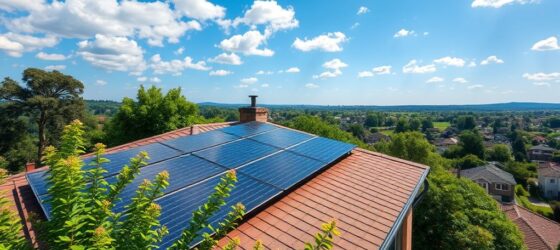
Recent Comments